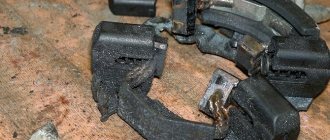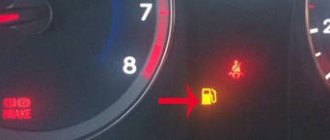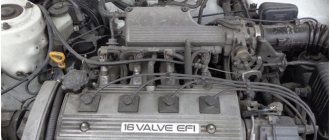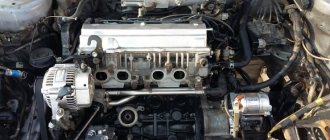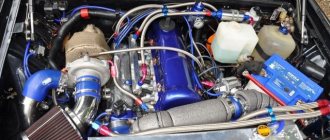Body
| Number of doors | 4 |
| Number of seats | 5 |
| Wheelbase | 2424 mm |
| Front track | 1365 mm |
| Rear track | 1321 mm |
| Ground clearance | 170 mm |
| Maximum trunk volume | 379 l |
| Width | 1620 mm |
| Length | 4145 mm |
| Height | 1440 mm |
This is interesting: In what city is the Nissan Terrano produced?
Technical characteristics of VAZ 2107
The model is a classic rear-wheel drive sedan. There are no front-wheel drive modifications for the VAZ 2107.
The car was only slightly different in size from its predecessor, the “six”:
- length - 4145 mm;
- width - 1620 mm;
- height - 1440 mm.
The curb weight of the “seven” was 1020 kg, the total weight was 1420 kg. As on all VAZ models, the fuel tank volume was 39 liters. For the vast majority of owners, the trunk volume of 325 liters provided the necessary space for transportation.
The latest versions of the “seven” were equipped with a remote control for automatically opening the trunk
Initially, carburetor modifications of power units were installed on VAZ 2107 cars. Depending on the year of manufacture, the engine could operate with either a four-speed gearbox or a five-speed gearbox.
An important feature of the engines on the “seven” is that until 1995 they were equipped with a breaker relay, which can be easily detected when braking with the handbrake.
The braking system was inherited from the “seven” from the “six”: front disc brakes and rear drum brakes.
The ground clearance of all VAZ modifications was not designed for off-road driving, but 175 mm of ground clearance makes it possible to cope perfectly with uneven road surfaces.
In total, over the entire period of production of the VAZ 2107, the car was equipped with five types of engines:
- model 1.5 liter or 1.6 liter, 65 hp, 8 valves, carburetor);
- model 1.3 liter, 63 hp, 8 valves, timing belt);
- model 1.7 liter, 84 hp, 8 valves, mono injection - version for export to Europe);
- model 1.4 liter, 63 hp, version for export to China);
- model 1.7 liter, 84 hp, 8 valves, central injection).
The power unit is located in the front of the machine in the longitudinal direction.
Video: main characteristics of the machine
Injector installation
Let's take a closer look at how to install an injector on a VAZ 2107. First of all, you need to drain some of the coolant, after which the carburetor, intake and exhaust manifolds are removed. An electric air blower is installed under the injector, so if a VAZ 2107 has a forced air blower, it also needs to be removed. The first thing to replace is the crankshaft pulley. To place the sensor on it, the new pulley must have special teeth. Next, the front engine cover and sealing gaskets are replaced.
During installation, you will need a coolant temperature sensor. To install it, you need an underflow located on the tee of the block head. A threaded hole is prepared for the sensor, after which the ebb is installed back. The sensor itself will come in handy after installing new wiring. Then the manifolds are installed with all the equipment attached to them, such as a fuel rail with injectors, a throttle valve and a receiver. The position sensor and idle air valve are bolted to the base of the manifold. The fuel pump and ignition system elements are replaced with plugs, after which the fuel filter is installed in any convenient place.
The gas tank is secured with clamps, and the fuel outlet line is connected to it. If the gas tank is not replaced with a new one, but the same one is installed, it is necessary to wipe it from the inside with a solvent. The electric fuel pump is installed approximately in the place where the gas tank is located, under the bottom of the car. A fuel line is also installed at the inlet to drain gasoline from the system into the gas tank.
You can stretch it in any way, but it is important that the line and the gas tank are tightly connected
Next, the ramp is attached to the manifold, and new wiring is installed. To install the latter, you need to have a good knowledge of the electrical equipment of the VAZ 2107 car. An on-board computer, wiring harnesses and injection sensors must be installed. The last step is to install the elements of the ignition system, high-voltage wires and the remaining sensors.
Engine
| Engine capacity | 1569 cm3 |
| Power | 75 hp |
| At rpm | 5400 |
| Torque | 116/3000 n*m |
| Gas distribution mechanism | OHC |
| Number of cylinders | 4 |
| Number of valves per cylinder | 2 |
| Cylinder diameter | 79 mm |
| Piston stroke | 80 mm |
| Compression ratio | 8.5 |
Fuel pump drive
The VAZ 2107 mechanical fuel pump is driven by a pusher and an eccentric. Among drivers, it is customary to call the pusher a rod, although the rod is another part of the fuel pump. The eccentric is located on the intermediate shaft, which operates from the gas distribution mechanism.
The fuel pump drive includes (see figure):
- 1 - pusher;
- 2 — heat-insulating spacer;
- 4 — adjusting gasket;
- 5 - sealing gasket;
- roller (cam).
The pusher is driven by an eccentric located on the shaft of the auxiliary mechanisms
Device and principle of operation
The operation of the mechanical fuel pump drive is not based on the fact that:
- the oil pump shaft is driven through a timing chain;
- the cam (or eccentric) begins to press cyclically on the pusher;
- The pusher transmits force to the lever and the fuel pump begins to pump fuel.
Drive faults
Problems with the mechanical fuel pump drive lead to interruptions in the operation of the fuel supply system. Actuator malfunctions are most often associated with deformation or excessive wear of the pushrod or cam.
Fuel pump rod bends
The fuel pump pusher is often made of metal that is not strong enough. There are often cases when, after 2–3 thousand kilometers, such a pusher bends and flattens the constant impact of the cam. The length of the pusher should be 82.5 mm. If your fuel pump tappet does not meet this size and is flattened on the cam side, it will need to be replaced.
If the fuel pump pusher is flattened on the cam side, it needs to be replaced.
Fuel tank capacity Lada - 1982
03.1982 — 04.2012
| Options | Fuel tank volume, l |
| 1.3 MT 21072 Basic | 39 |
| 1.5 MT 2107-20 Basic | 39 |
| 1.5 MT 2107 Basic | 39 |
| 1.6 MT3 Standard | 39 |
| 1.6MT5 | 39 |
| 1.6MT3 | 39 |
| 1.6 MT5 Standard | 39 |
| 1.6 MT2 Standard | 39 |
| 1.6MT2 | 39 |
| 1.6MT3 | 39 |
| 1.6MT1 | 39 |
| 1.6 MT3 Standard | 39 |
| 1.6 MT5 Standard | 39 |
| 1.6MT 21074 | 39 |
| 1.6 MT 21074 Basic | 39 |
| 1.7 MT 2107 Basic | 39 |
| 1.3 MT 21079 Basic | 40 |
This is interesting: How to set the Starline temperature
How much gas does your classic consume? | Topic author: Mehar
my 21053 with a carburetor eats 12 in the city, 9 on the highway, does everyone have that much?
Roma (Sigalia) 2107 with 83 carb 7 liters on the highway
Alexander (Saheerah) Sergey )))))))) Klinkov My 21053 I don’t know how much it eats, but 25 liters is enough for approximately 190 – 200 km.
Igor (Hisein) 2105 with a 1.3 engine on highway 7 in the city 9-10.
Ruslan (Anaia) my seven injector in the city 11, 8-12 liters
Sergey (Chambers) Seven, carb, 10 in the city. This is in the summer. More in winter
Pavel (Richerd) Five 2005 6-7 liter carburetor
Ilnur (Hawla) VAZ 21053 carburetor, on the highway 6 liters per hundred, in winter. Check the carburetor
Andryukha (Goredema) Five 1994 —6l on the highway, —-8 in the city 1.5k
Maxim (Clarabelle) 5/5-7
Maxim (Clarabelle) 2105 engine 1.9, 13 city 10 highway.
Igor (Hisein) what kind of engine is this 1.9.
Maxim (Clarabelle) Nivsky exact.
Sergey (Chambers) 2107, engine 03, on the highway 7, 5 city 9, if you drive 15
Performance indicators
| Maximum speed | 150 km/h |
| Acceleration time (0-100 km/h) | 16 s |
| Fuel consumption in the city per 100 km | 9.6 l |
| Fuel consumption on the highway per 100 km | 6.8 l |
| Combined fuel consumption per 100 km | 9.2 l |
| Fuel tank volume | 39 l |
| Vehicle curb weight | 1060 kg |
| Permissible gross weight | 1430 kg |
| Tire size | 175/70 R13 |
Possibilities for upgrading the machine
In the nineties of the last century, many owners of VAZ 2107 cars, not particularly counting on gas stations, installed an additional tank in the car. This is much more convenient than pouring fuel from cans. Typically, such a container was located behind the rear seat in the trunk. It could have different sizes, and accordingly they had the appropriate capacity.
The driver in those days often encountered empty gas stations, and the additional volume of the fuel tank greatly expanded the capabilities of the car. Knowing the required amount of technical fluids is necessary for routine maintenance of the engine and other systems.
Other
VAZ 2107 21074 1.6 MT is a 4-door car with a 5-speed gearbox. With the number of seats for the driver and passengers: 5. The maximum possible speed is 150 km/h. The car accelerates to 100 km/h in 16 seconds. Average fuel consumption per 100 km is: in the urban cycle - 9.6 liters, on the highway - 6.8 liters, in the combined cycle - 9.2 liters. Maximum fuel tank volume is 39 l. A full tank is enough for approximately: 406 km when driving around the city, 574 km when driving on the highway, 424 km when driving the combined cycle. The maximum carrying capacity of the vehicle is 370 kg.
- Fuel consumption VAZ 2107
- Maximum speed of VAZ 2107
- Dimensions and dimensions of the VAZ 2107
- Acceleration to 100 km/h VAZ 2107
Transmission
| Clutch | single-disk, dry, with hydraulic shutdown drive and central diaphragm spring |
| Transmission | mechanical, four- or five-speed, three-way, three-shaft, with synchronizers on all forward gears |
| Gear ratios: | |
| first | 3,67 |
| second | 2,10 |
| third | 1,36 |
| fourth | 1,0 |
| fifth | 0,82 |
| reverse | 3,53 |
| Cardan transmission | two-shaft, with intermediate support and elastic coupling |
| main gear | hypoid |
| Final drive ratio | gear ratio – 3.9 or 4.1 |
| Differential | conical, two-satellite |
Tuning VAZ → there is not enough gasoline in the tank. what to do?
about 25 liters of gasoline enters, after which the gun turns off (gasoline is visible in the neck). the sensor shows a full tank - it’s lying to me)) tell me what’s wrong? car 2107 injector
- Senya_Sid
- 10 January 2021, 15:45
- Maxim_Potapov
- 10 January 2021, 15:50
- v
- Stanny_Eliseev
- 10 January 2021, 15:51
- v
- Igor_Grigorev
- 11 January 2021, 04:56
- v
- Stanny_Eliseev
- 11 January 2021, 07:46
- v
- Gorik_Kurochkin
- 11 January 2021, 08:48
- v
- Maxim_Smirnov
- 11 January 2021, 16:26
- v
- Maxim_Potapov
- 11 January 2021, 16:28
- v
- Senya_Sid
- 11 January 2021, 16:29
- v
- Senya_Sid
- 11 January 2021, 16:37
- v
- Maxim_Potapov
- 11 January 2021, 17:23
- v
- Sergey_Shevelev
- 11 January 2021, 17:38
- v
- Vengr_Koryakov
- 11 January 2021, 17:56
- v
- Stanny_Eliseev
- 11 January 2021, 20:53
- v
- Vengr_Koryakov
- 12 January 2021, 07:03
- v
- Stanny_Eliseev
- 12 January 2021, 07:29
- v
- Vengr_Koryakov
- 12 January 2021, 07:34
- v
- Stanny_Eliseev
- 12 January 2021, 10:47
- v
- Vengr_Koryakov
- 12 January 2021, 18:35
- v
because my father always had 4-6 liters left on the carb when it caught fire, and I have 10-12 liters left, that’s the difference; it was done so that the pump would not overheat
How to solve a problem?
A new electric fuel pump gasket is required. It is very easy to replace it. First you need to relieve the pressure in the injector power system. To do this, you need to start the engine and remove the fuse for the pump while the engine is running. After a couple of seconds the car will stall on its own. Next, you need to open the trunk and use a 7 key to unscrew the submersible pump mounting bolts in order. It is a one-piece structure that combines a coarse filter, a gasoline level indicator, fuel lines, an anti-drip cup and a cover.
After unscrewing all eight bolts, you need to remove the pump by removing the wire plug. Be careful - when removing, the fuel level indicator may get stuck (it is slightly bent and has a float at the end).
Replacement of gas tank and major repairs
Regardless of what type of fuel injection is used on your vehicle, the process for removing the tank will be the same. First drain all fuel from it. Next, carry out the following work:
- Remove the plastic casing from the container. To do this, you will need to unscrew several screws using a Phillips screwdriver.
- Disconnect the wires from the contacts leading to the fuel sensor.
- Use pliers to pry off the fuel hose.
- Unscrew the bolt of the tension plate that secures the gas tank.
- Remove the cap from the neck and carefully remove the tank.
Assess its condition. If there are several leaks or they are too large, then it will be easier to replace the entire fuel container. To do this, simply take a new tank and reassemble it in the reverse order.
If you do not have the opportunity to buy a new container, then stock up on:
- fiberglass;
- epoxy resin;
- acetone;
- sanding paper.
First, dry the tank thoroughly; if you start repairs immediately after dismantling, you will be disappointed with the result. Next, proceed to repair work:
- Cut the fiberglass into pieces so that they completely cover the leaks or holes.
- Impregnate the material with epoxy resin.
- Lay the fiberglass cloth over the leak area and level it so that there are no bubbles on the surface. Remove excess resin. The first layer is the most important, so take your time.
- Dry the patches, then putty them and paint them with primer.
Such repairs may last for varying periods of time from 3 months to 3 years. It all depends on the climate and the degree of neglect of corrosion processes. It is more effective to immediately change the tank, then you won’t have to worry that the patch will let you down. The cost of a new spare part is about 3 thousand rubles.
Main malfunctions in the sensor operation
How many liters of diesel fuel in one ton
If the sensor does not display the fuel level correctly, you can judge that a certain breakdown has occurred and needs to be repaired. Modern sensors that record the fuel level, like all vehicle parts, fail from time to time. In this case, it is necessary to repair the fuel level sensor.
Malfunction in indicators
The main sign of a sensor failure is the display of false data displayed on the pointer. Based on its “behavior,” certain conclusions can be drawn regarding the resulting breakdown. Here are the most basic types of breakdowns and their causes:
The indicator is at zero, regardless of the fuel level. The problem is that the float stop is broken. The pointer moves, but still drops to the zero mark. In this case, you need to pay attention to the general condition of the device winding, as well as the reliability of the contact between the sensor and the current collector. Fluctuations in fuel quantity indicators. This malfunction indicates sufficient wear on the contacts. When starting the engine, the fuel gauge does not rise above the zero mark. Such a malfunction is directly related to the electronics of the vehicle
Here it is important to check the wires for possible breaks and the degree of reliability of the connection. It is important to ensure the overall integrity of the fuse. Low fuel light does not light up
This problem is often associated with device failure. The fuel level sensor is lying. In such a situation, it will be necessary to check the float for the level of tightness.
According to modern traffic regulations, operating a car with a faulty indicator is strictly prohibited. Problems that arise with sensors must be eliminated as promptly as possible.
Mechanical and functional malfunction
Along with problems that are expressed in incorrect indicators, sensor failure can manifest itself in the following malfunctions:
- loss of tightness of the built-in float;
- strong bending of the wire holder;
- violation of the general tightness of the housing and the resulting decrease in the level of resistance;
- mechanical break of the variable resistor;
- loss of tightness at the point where the device is attached to the fuel tank.
After the float loses proper tightness, the control device, with a full tank, will indicate an incomplete fuel level. If there is a sufficiently strong loss of tightness, the indicator will immediately show the minimum fuel level. In this case, the actual quantity will not matter. To fix this problem, you will need to remove the sensor and replace the float. If it is not possible to purchase a float, you will need to completely replace the entire device.
Quite often, the sensor fails due to long-term movement over rough or uneven terrain. Repeated impacts on the tank will cause serious damage to the wire holder of the built-in float.
With such bends, the behavior of the indicator will directly depend on where the holder was bent. If the bend is directed upward, the parameters will always be increased, if downward, the parameters will be underestimated. If the breakdown involves such a bend, you just need to straighten the wire holder and give it its original shape.
Often the seal of the sensor housing is broken. This happens after an accident has occurred, as well as after long-term use of low quality fuel. If gasoline gets into the device, it will malfunction and, as a result, cause incorrect sensor readings. These malfunctions can only be eliminated by completely replacing the device.
If the variable resistor breaks, this will cause the sensor to always show a full or completely empty tank. Similar signs can be observed in the process of a break in the signal wire running from the sensor to the display unit. Before removing the sensor, you will need to connect a variable resistor with a resistance level of 100 - 200 Ohms to the car body and to the signal contact. As you rotate the knob, you need to make sure that the sensor readings change. In this case, the malfunction can only be eliminated by completely replacing the device.
The main sign of a complete loss of tightness at the installation site of the device is the appearance of the smell of gasoline in the cabin.
All about model refueling fluids
As mentioned above, the VAZ 2107, like all models of the manufacturer, is equipped with a 39-liter gas tank. This volume is quite enough for long continuous trips. Of course, in recent years, due to a sharp increase in fuel prices, the tank volume has become enough for only 3-4 hours of driving on the highway.
Fuel
Initially, the “seven” was refueled exclusively with A-92 gasoline. However, some of the latest versions of the model implied the use of diesel fuel (VAZ 2107 - diesel). However, diesel modifications of the VAZ 2107 did not gain popularity in Russia due to the high cost of the car and increased fuel consumption.
AI-92 fuel is the main filling fluid for the engine
Engine oil
Another filling fluid for the car is the oil in the power unit. AvtoVAZ engineers recommend that drivers fill the engine with lubricant that meets the minimum requirements of API SG/CD standards . This marking is usually indicated on containers with consumable liquid.
For VAZ 2107 engines, according to the SAE classification, the following oils are recommended:
- Lukoil Lux - 5W40, 10W40, 15W40.
- Lukoil Super - 5W30, 5W40, 10W40, 15W40.
- Novoil-Sint - 5W30.
- Omskoil Lux - 5W30, 5W40, 10W30, 10W40, 15W40, 20W40.
- Norsi Extra - 5W30, 10W30, 5W40, 10W40, 15W40.
- Esso Ultra - 10W40.
- Esso Uniflo - 10W40, 15W40.
- Shell Helix Super - 10W40.
Where oil is present, experts recommend changing the oil filter as well.
Transmission oil
It is also necessary to maintain an optimal level of lubrication in the gearbox - transmission. For VAZ 2107 with 4 and 5-speed gearboxes, the same types of transmission oils are used.
AvtoVAZ engineers draw the attention of owners that only special gear oil of groups GL-4 or GL-5 should be poured into the gearbox. The viscosity grade must be designated SAE75W90, SAE75W85 or SAE80W85.
It is important not to overdo it with pouring lubricant into the transmission: no more than 1.35 liters of oil can be poured into a four-speed gearbox, and 1.6 liters of oil into a five-speed gearbox.
When changing transmission oil, it is necessary to fill in a clearly defined amount of fluid.
Coolant
The VAZ 2107 power unit needs high-quality cooling. Therefore, all versions of the “Seven” have a liquid cooling system. It is based on antifreeze. In the 1980s, the use of antifreeze was not practiced in the USSR, so engineers used only antifreeze to cool the engine .
In recent years, car enthusiasts have been pouring both antifreeze and antifreeze into the expansion tank without any consequences for the operation of the car. In some cases, during the summer months it is even possible to use ordinary water as a coolant, but the manufacturer does not recommend adding water.
Operating a car without coolant can lead to overheating and engine damage.
Antifreeze volume in the car
The first thing you need to know is how much antifreeze can be poured into a VAZ 2107 so that it works stably. For cars of brands such as VAZ 2101, 2105, 2106 and VAZ 2107, the volume of fluid is the same - 9.85 liters, it must be replaced every two years. Replacing antifreeze on a VAZ 2107 occurs in the following way:
The first thing you need to pay attention to is the cooling system; if it is clogged, it needs to be washed with special products or water. Next, you need to take a spanner wrench and a container of at least ten liters to drain the old car fluid
It is very important that the radiator is cold when replacing, since antifreeze is a harmful substance, and when heated it also becomes very toxic.. https://www.youtube.com/watch?v=mHA79B8GhnY
The volume of coolant in a VAZ 2107 can reach up to ten liters. Antifreeze is suitable for the engine cooling system, as it prevents heat from entering the engine and cools the radiator. The cooled antifreeze is moved to the car engine using a pump. This process continues until engine operation stops. During operation, antifreeze heats up and loses its positive properties, so it must be changed periodically. The process of heating the antifreeze occurs when the car travels a distance of about 60 thousand kilometers.
Description of the salon
Having first appeared in 1982, the VAZ 2107 did not differ from its predecessors and competitors in any modern devices or design. However, even those little things that the manufacturer decided to introduce into the new Lada model played into the hands: the car became more convenient and attractive for drivers.
Interior trim
The interior trim was fully consistent with Soviet ideas about fashion. For example, higher quality plastic and wear-resistant fabrics were used. For the first time, the seats acquired an anatomical shape and received comfortable headrests. In general, the VAZ 2107 was the first in the manufacturer’s line to receive the title of a comfortable car for people.
Hard plastics and wear-resistant fabrics are used for interior upholstery.
Dashboard
However, if the interior, at the very least, stood out from similar AvtoVAZ models, the instrument panel was always made in strict accordance with existing standards. We can say that the dashboard is featureless, although it houses the tachometer and additional services of instruments and sensors.
On the panel there are only important devices, without decorations or frills.
This is probably why almost all VAZ 2107 owners try to somehow personalize the instrument panel in their cars. Some hang icons, others - flavors, others - toys... After all, a dull instrument panel affects the mood, so depending on capabilities and taste, drivers often resort to tuning this area of the car.
Gear shift diagram
The gearbox on the VAZ 2107 is needed to transmit torque from the engine to the transmission.
The gear shift pattern on a five-speed gearbox is not much different from a four-speed one: the only difference is that another speed has been added, which is activated by pressing the lever all the way to the left and forward.
The gear shift pattern on a five-speed gearbox is not much different from a four-speed one.
All 7 gearboxes also have reverse gear. The transmission itself is necessarily sewn into the housing with a lever located on it to change gears.
Checking the valve with a multimeter
Review of UAZ 469: characteristics and capabilities of the model
You can also perform diagnostics with a voltmeter. How to check the fuel canister check valve? You need to open the hood and disconnect the wiring harness connector from the valve. Next, connect the negative probe of the multimeter to ground and turn on the ignition. Then bring the positive probe to the wire chip and look at the values of the device. The readings should not be lower than 12 V.
To inspect the valve itself, loosen the hose clamp with a screwdriver and remove the tube outward. Next you need to remove the valve itself by prying it off with a slotted screwdriver. It is necessary to turn on the ignition and apply “plus” and “minus” to the corresponding terminals on the element. If the valve is working properly, you will hear a characteristic click. Otherwise, the element is defective and must be replaced. The cost of a new element is 350 - 370 rubles (suitable for a VAZ of the tenth family).
To replace the valve, you only need a slotted screwdriver. She needs to unscrew the clamps of the gasoline hoses and pry off the edges of the element. The new one must be installed tightly into the grooves until it clicks. Next, put the hoses on the valve and tighten the clamps. At this point, the replacement of the Semyorka adsorber valve has been successfully completed.


